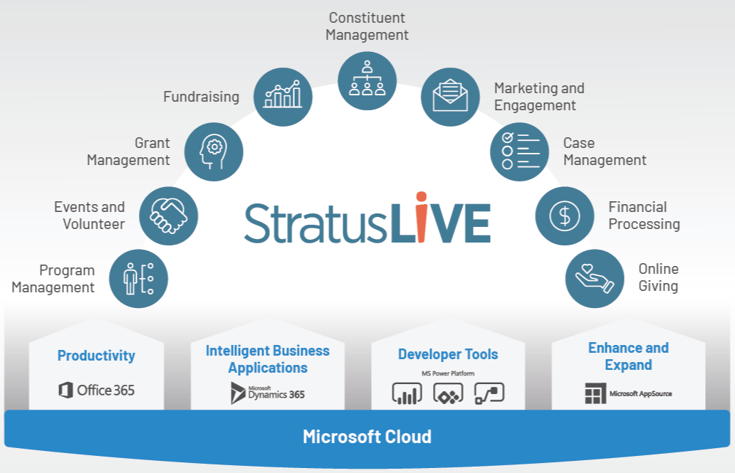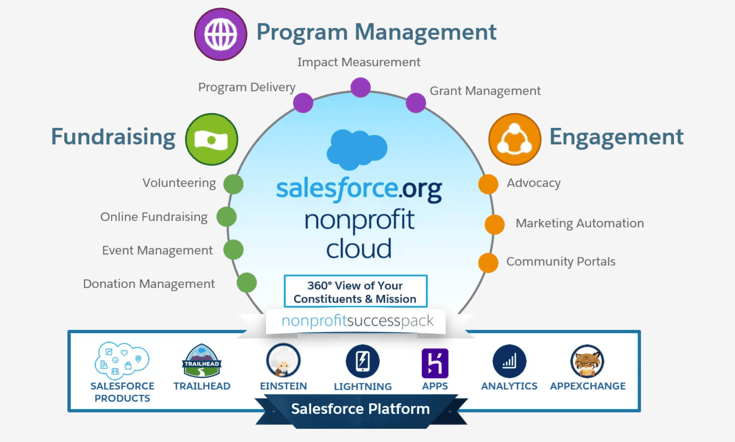StratusLIVE and Salesforce both offer nonprofit clouds that bring fundraising, program management, and engagement solutions into one integrated platform. Keep reading for a deep dive Nonprofit CRM Comparison.
StratusLIVE 365 is built on Microsoft Dynamics 365. The Microsoft platform is designed to seamlessly work together with all the Microsoft tools you already know and use: Teams, Outlook, Excel, PowerPoint, SharePoint, Skype, Word, Trello, and more. While Salesforce does integrate with some of those same Office apps, they are each separate integrations that need to be individually synced.
Unlike Salesforce, when linked together, StratusLIVE 365 turns Outlook into a one-stop-shop for managing donor information.
Here is a visual of the StratusLIVE Nonprofit Cloud:

Here is a visual of the Salesforce Nonprofit Cloud:

Recently, we compared the out-of-the-box Salesforce Nonprofit Success Pack (both in Classic as well as the Lightning edition) StratusLIVE 365.
Here are a few key observations and differences between the two:
1. Householding and how Accounts and Contacts are treated
I will start with a quote I found in the Salesforce training materials that I found interesting: “Everything in Salesforce revolves around the Account.” Now at first glance that seems like they are saying that everything revolves around a customer, and while that might be true, it is not easy to individualize giving and concentrate on a person. In the non-profit space, we work with people and want to treat them individually. As with most Customer Relationship Systems, they were initially designed for a Business to Business type of sales. Salesforce has kept that model in the Nonprofit Success Pack. I will have more examples below of where this becomes important.
StratusLIVE 365 keeps all transactions and interactions available at both the Account and/or Contact levels. So the gift a person made is always at the donor level, not just at a household level.
Speaking of Householding capabilities, in Salesforce, you are always required to set up an account when you set up a Contact. And while this is done automatically for you, it will double your record count and storage of your donors. In many systems, this comes with an additional storage cost. You do have a chance to mark a contact as “Private,” but that severely limits some functionality. In StratusLIVE 365, a contact is distinguished as the head of household. It is related to all other household members, which allows for easy rolling up of transactions and interactions and keeps your primary record count lower.
In Salesforce, when dealing strictly with those contacts marked as “private,” you cannot create a workflow to automate anything around those contacts, and you cannot create transactions for them. I see these as significant issues for tracking and that you cannot automate anything unless there is a household account present.
In StratusLIVE 365, you can implement workflows to automate actions to ANY entity or record type.
Finally, within the householding area, when you add additional members to a household account within Salesforce, there is no automatic creation of relationship records between other members of the same household. You must do that as an additional step. In StratusLIVE 365, when adding a new household member, you select the relationship type to the primary household contact. The system automatically creates a Connection between those household members.
2. Campaign Treatment and Donor Engagement
There is a Campaign entity in Salesforce that allows for tracking overall campaigns, which can be related to financial transactions. However, there is no additional campaign structure available. In the nonprofit space, we often want to know what appeal and what package the donations and responses are being made. In StratusLIVE, there is a complete Campaign structure that can even go down to the Source Code level. Also, there are roll-up type fields that allow you to group your campaigns into different categories and campaign periods for reporting purposes.
Salesforce allows you to enter a donation without even relating it to a Campaign, which creates the donation without any related Designations/Funds (GAUs) on the gift. This would make it extremely difficult to track the source and revenue of a gift. StratusLIVE 365 requires that a campaign be entered for every transaction. Those transactions must be related to a designation/fund to allow for easy GL extracts for revenue, receivables, and cash tracking.
Engagement plans are often related to asks that nonprofits make of donors; this could be for Major Gifts, Sponsorships, Planned Giving, etc. There are no out-of-the-box Engagement Plans in Salesforce. So, while you can set up workflows, there is nothing to assist a Major Gift Officer in working through a moves management process. StratusLIVE 365 includes a Moves Management business process flow that leads a salesperson through the stages and prompts them with activities that they need to perform at each stage.
3. Other Key Observations
Above we covered some specific examples of how the software is different. Still, there are also some critical observations on customer solutions and how the products are implemented/supported.
We’ll start with customer solutions. Often, Salesforce is touted as having a vast network of third-party products that allow you to bolt on almost anything you can think of. In the world of App Stores, that sounds like the perfect solution for all of us. However, keep in mind that StratusLIVE 365 is built on top of Dynamics 365. Microsoft also has an app store where third-party products can be purchased and bolted onto the StratusLIVE 365 solution. So the option is there, but is having access to all these different solutions always for the best?
Let’s take one small example; credit card processing. In Salesforce, credit card processing is not included out of the box. Still, I found at least a half dozen bolt-on products that would allow me to process credit card gifts. Sounds good so far, except that now I also need to pay them at least a monthly fee, and in many cases, I also pay them per transaction. Not to mention, if something goes wrong with that small capability, I need to contact a different organization to get it fixed.
In StratusLIVE 365, credit card processing is included out-of-the-box in a solution we built and support. More importantly, this is directly linked to your merchant account, so StratusLIVE never takes fees off the top. Your credit card fees are whatever you have negotiated, and there are no additional monthly fees to use it.
Finally, there is a crucial difference in how implementations and support are conducted.
Salesforce is a company that is building a broad, slightly verticalized nonprofit solution that relies on a partner channel to implement and customize a specific solution for your organization. So, you buy the product from Salesforce. Then you also negotiate with potentially 3 or 4 implementation partners to find one that best matches the way you need your solution set up. They can undoubtedly customize the Salesforce solution to exactly meet your needs but at what additional cost? Not to mention whom do you call for support? Let’s say that your data entry person is entering donations, and the screen freezes. Do you have to contact Salesforce or the implementation partner, or the third-party credit card app provider? Who is responsible for resolving the issue?
A real-life example of this is for one of our clients. They were on the Salesforce platform and struggled with yearly challenges in cost overruns, missed functionality, and complicated separate integrators. Because there was not one accountable partner, they had no one particular contact that understood their overall business model and desired program outcomes.
In closing:
StratusLIVE has taken the Dynamics 365 product from Microsoft and built a fully functional nonprofit solution on top of that application. When you purchase from us, we will make sure you have what you need from Microsoft, and we will implement the solution for you. If you need configuration changes, we can either modify the core solution for all our clients (if it makes sense) or build a specific solution to your needs. Not only that, but we will fully support all the applications and solutions and even act as tier one support for issues with the Microsoft application. If you need a third-party solution, we review what is available, vet them against our solution to ensure there are no issues, and then let you know the best-of-breed solution we would recommend.






